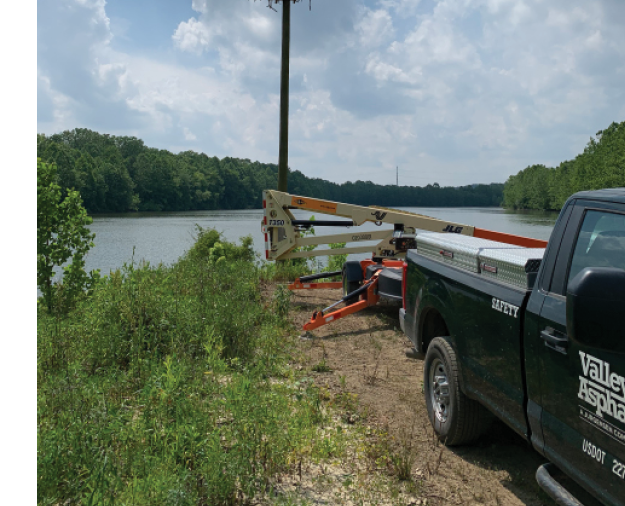Valley Asphalt Creates Habitats For Osprey And Helps Rebuild The Local Population.
By Therese Dunphy
After a three-day weekend approximately 15 years ago, the team at Cincinnati, Ohio-based Valley Asphalt, a Jurgensen Company, returned to work to an unusual sight: an osprey nest built on top of the crane that the operation used to lift parts around the site.
“When we’re done with a crane at the end of a project, they’ll normally leave the boom up in the air, which it was,” said Dan Crago, P.E., director of environmental and quality control. The boom was at the right height to attract a pair of ospreys, which often nest in trees near water. The operation is located along some pristine lakes with wide availability of fish, as well as the Little Miami River, making it an ideal setting for the species, which was nearly extinct in the state 60 years ago.
Once the nest was spotted, the company reached out to the Ohio Department of Natural Resources (ODNR) as well as a Cincinnati-based non-profit called Raptor Inc., which is dedicated to the conservation of birds of prey. Both groups told the operation that the best route would be to leave the nest up through the season and allow any eggs to hatch. At the time, osprey was a protected species, so they did precisely that.
According to Erin Tarmey, the company’s accounting specialist who has spearheaded the care of birds and animals at the site, ospreys typically arrive at the site in early March and lay two to three eggs in mid to late April. The chicks grow quickly and learn how to fly at eight weeks. By the end of July, they usually migrate to South America where they remain until they are two to three years old and return to where they were born to find nesting territories of their own.

Cultivating Conservation
The first nest prompted a discussion about what the site could do to keep birds off of active equipment but still foster a protective environment. The result? The company installed three utility poles and built 5- x 5-ft. platforms at the top. Bolts stick up through the bottom of the platforms to prevent sliding of the stick nests.
The company has also formed an ongoing relationship with Raptor Inc., which comes out each year to tag the chicks before they migrate away. This allows them to capture data on distance, routes and timelines of activities, according to Tarmey. The site also teamed up with the Little Miami Conservancy, which installed a live-feed camera on one of the osprey nests. It can be viewed at www.youtube.com/watch?v=I_Xs0mTNyLA.
“Now that we have the camera on the one nest, we can see it for ourselves,” Tarmey explained. “People keep an eye on their activity, and I get updated so that I know when the eggs hatch and can call people in to do the tagging.”
Expanding Opportunities
“Sharing information, working with our neighbors, providing distance and privacy to resident wildlife, and consciously making an effort to coexist safely and proactively with nature have shown abundant rewards,” Tarmey said. “Efforts and ideas are ongoing for ways we can step in when it’s required and do our part to help when possible.”
For example, Valley Asphalt shares field notes, data and resources with neighboring operations. One such producer, Oeder Sand & Gravel, has built its own pole and attracted another osprey pair. These operators have become an integral part of Ohio’s osprey reintroduction program, which began in 1996. At the time, the goal was to have 20 nesting pairs by 2010. That goal was exceeded in 2003. In 2019, Tarmey said that wildlife biologists reported 145 osprey chicks were produced in 110 nests. The program has been so successful that the ODNR Division of Wildlife has removed the osprey from the state’s threatened species list.
And, for the most part, the ospreys leave the equipment at the site alone. “I think that putting up a designated safe area for them to reproduce and live in peace has really helped rejuvenate their numbers,” Tarmey said. “I feel like we co-exist pretty peacefully. We leave them alone, and they leave us alone.”

Therese Dunphy has covered the aggregates industry for nearly 30 years, while also serving multiple roles as a public official. As the owner of Stone Age Communications, she provides communications consulting services to help aggregate producers build stronger relationships within the communities they serve. She can be reached at [email protected].
